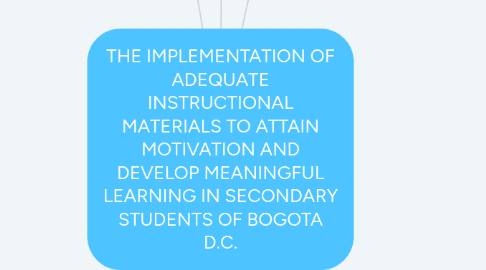
1. Pedagogical Intervention
1.1. Diagnostic tests
1.1.1. Formats of school procedures
1.1.1.1. Group 2
1.1.1.1.1. meaning of basic words
1.1.1.1.2. ing verbs
1.1.1.1.3. Action words
1.1.1.1.4. order sentences
1.1.1.2. Group 4
1.1.1.2.1. Reading
1.1.1.2.2. present and past
1.1.1.3. Group 6
1.1.1.3.1. complete the words
1.1.1.3.2. Doing paragraphs
1.1.1.3.3. Posing questions
1.1.2. immediate previous academic year
1.1.3. analyze the students’ notions
1.2. Types of materials
1.2.1. Non projected display materials
1.2.1.1. visual aids of tangible use
1.2.1.1.1. Flipcharts
1.2.1.1.2. Semi-finished samples of manufacturated articles
1.2.1.1.3. Instruments for demonstration
1.2.1.1.4. Supplies or equipment
1.2.2. Printed and duplicated materials
1.2.2.1. Reading comprehension
1.2.2.1.1. handouts
1.2.2.1.2. Assignment sheets
1.2.2.1.3. Textbooks
1.2.2.1.4. manuals
1.2.3. Still projected display materials
1.2.3.1. visual aids, multimedia representations of an actual phenomena
1.2.3.1.1. slides
1.2.3.1.2. photos
1.2.3.1.3. illustrations
1.2.4. Technological instructional media
1.2.4.1. digital means that provide a software
1.2.4.1.1. simplify work.
1.3. Instructional design
1.3.1. Use of culture-based materials
1.3.2. Implementation
1.3.2.1. Networks for learning
1.3.2.2. Comics
1.3.2.3. Foreign articles
1.3.2.4. Drawings or role playing
1.3.2.5. Short videos
1.4. Roles
1.4.1. Learners
1.4.1.1. use of communication
1.4.1.1.1. task-based
1.4.2. Teachers
1.4.2.1. Collect data
1.4.2.1.1. pre-task
1.4.2.1.2. task
1.4.2.1.3. post-task
1.5. Assessment
1.5.1. performance quizzes
1.5.1.1. performance assessment
1.5.2. methods
1.5.2.1. Selected response and short answer
1.5.2.2. Extended written response
1.5.2.3. Performance assessment
1.5.2.4. Personal communication
1.5.2.5. Quiz for group two during week eight
1.5.2.6. Quiz for group four during week eight
1.5.2.7. Quiz for group six during week eight
2. Analysis and findings
2.1. materials
2.1.1. activation of language acquisition device and prior knowledge
2.1.1.1. learners encouragement in contact with the knowledge.
2.1.1.1.1. satisfactory comprehension of taught contents.
2.2. students
2.2.1. G2
2.2.1.1. progresses
2.2.1.1.1. Dictation of words
2.2.1.2. assessment requirements
2.2.1.2.1. reliability
2.2.1.2.2. construct validity
2.2.1.2.3. authenticity
2.2.1.2.4. , interactivity
2.2.1.2.5. , impact
2.2.1.2.6. practicality
2.2.2. G4
2.2.2.1. NEED
2.2.2.1.1. reinforcement
2.2.3. G6
2.2.3.1. satisfactory development
2.2.3.1.1. use of proper grammar
2.2.3.1.2. writing
2.2.3.1.3. narrating sentences
2.2.3.1.4. meaningful thinking
2.2.3.2. appeared to express meaningful thinking on ideas they presented , however one of the
2.2.3.3. shortcomings appeared was in pronunciation of the words when reading the monologue.
3. Problem statement
3.1. The lack of motivation to learn a second language
3.1.1. Materials
3.1.1.1. do not let students to develop metacognition
3.1.1.1.1. the students’ capacity to go deep in different concepts in learning
3.1.1.2. do not contain interesting topics
3.1.1.3. do not offer a motivating atmosphere
3.1.2. Context
3.1.2.1. Colombia
3.1.2.1.1. is in 49th/72nd place in performance in 2nd language
4. Literature Review
4.1. Theories
4.1.1. meaningful learning
4.1.1.1. David Ausubel 1961
4.1.1.1.1. Is the sum of all the knowledge humans have acquired.
4.1.2. metacognition
4.1.2.1. John Flavell (1979)
4.1.2.1.1. the way to think about thinking to reflect about reflect that requires constant reviewing from the teacher
4.1.2.2. Materials
4.1.2.2.1. motivating and instructional for 2nd language
4.1.2.2.2. Reflective
4.1.3. Comprehensible input
4.1.3.1. complete exposition to a target language
4.1.4. Affective filter
4.1.4.1. all the emotional variables that influence in the process of language acquisition
4.1.4.2. Anxiety
4.1.4.2.1. Krashen (1981)
4.1.5. motivation
4.1.5.1. priority to acquire language
4.1.6. Self-esteem/self-confidence
4.1.6.1. dominant component of social psychology
4.1.6.1.1. self-reliance.
4.1.6.1.2. scholars' perceptions of concept and the components that shape an idea
4.1.7. Second Language Acquisition
4.1.7.1. Krashen (1982)
4.1.7.1.1. A subconscious process
4.1.7.1.2. Acculturation
4.1.8. Constructivism
4.1.8.1. Bandura (1977)
4.1.8.1.1. social learning system
4.1.8.2. Piaget (1952)
4.1.8.2.1. The intelligence and construction of knowledge
4.1.9. Language Acquisition Device
4.1.9.1. Noam Chomsky (1967)
4.1.9.1.1. a module of human beings
4.1.9.1.2. one component of the total system of intellectual structures
4.1.10. Theory of instruction
4.1.10.1. Brunner
4.1.10.1.1. the construction of statements and restatements
4.1.11. Task Based Instruction
4.1.11.1. Communicative Competence of Learning
4.1.11.2. meaningful tasks
4.1.11.2.1. Group work
4.1.11.3. 'International journal of linguistics'
4.1.11.3.1. Instruction
5. Research design
5.1. Type of study
5.1.1. qualitative
5.1.1.1. Data Collection Surveys
5.1.1.1.1. Affective filter
5.1.1.1.2. Theories
5.1.1.2. observations
5.2. Research method
5.2.1. inductive
5.3. Objectives
5.3.1. develop meaningful learning
5.3.1.1. instructional-motivating activities.
5.3.1.1.1. provide adequate atmosphere in teaching to secondary students
5.3.1.1.2. To diminish possible emerging levels of anxiety in preteenagers
5.4. data collection and procedures
5.4.1. Grounded Theory
5.4.1.1. a way to collect some data at social level,
5.4.1.1.1. discuss the creation of a specific phenomenon
5.4.1.1.2. compares procedures carried out in practice
5.4.1.2. PURPOSE
5.4.1.2.1. develop a theory
5.4.2. Surveys
5.4.2.1. collect data and information
5.4.2.1.1. affect motivation
5.4.3. Setting description and participants
5.4.3.1. Setting and population
5.4.3.1.1. School 'Nuestra Señora de las Victorias'
5.4.3.2. Participants
5.4.3.2.1. 6th, 8th and 10th grade students
5.4.3.2.2. Unit of analysis
